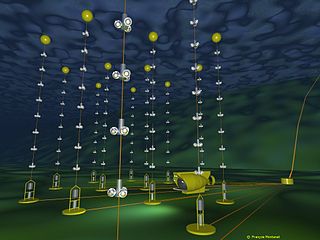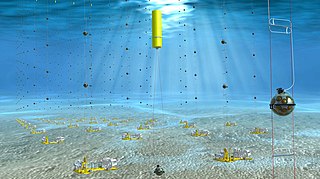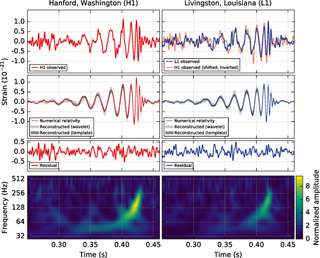Related Research Articles

Neutrino astronomy is the branch of astronomy that observes astronomical objects with neutrino detectors in special observatories. Neutrinos are created as a result of certain types of radioactive decay, nuclear reactions such as those that take place in the Sun or high energy astrophysical phenomena, in nuclear reactors, or when cosmic rays hit atoms in the atmosphere. Neutrinos rarely interact with matter, meaning that it is unlikely for them to scatter along their trajectory, unlike photons. Therefore, neutrinos offer a unique opportunity to observe processes that are inaccessible to optical telescopes, such as reactions in the Sun's core. Neutrinos can also offer a very strong pointing direction compared to charged particle cosmic rays.

The Antarctic Muon And Neutrino Detector Array (AMANDA) is a neutrino telescope located beneath the Amundsen–Scott South Pole Station. In 2005, after nine years of operation, AMANDA officially became part of its successor project, the IceCube Neutrino Observatory.

The IceCube Neutrino Observatory is a neutrino observatory constructed at the Amundsen–Scott South Pole Station in Antarctica. The project is a recognized CERN experiment (RE10). Its thousands of sensors are located under the Antarctic ice, distributed over a cubic kilometre.

The Antarctic Impulsive Transient Antenna (ANITA) experiment has been designed to study ultra-high-energy (UHE) cosmic neutrinos by detecting the radio pulses emitted by their interactions with the Antarctic ice sheet. This is to be accomplished using an array of radio antennas suspended from a helium balloon flying at a height of about 37,000 meters.
The Askaryan radiation also known as Askaryan effect is the phenomenon whereby a particle traveling faster than the phase velocity of light in a dense dielectric produces a shower of secondary charged particles which contains a charge anisotropy and thus emits a cone of coherent radiation in the radio or microwave part of the electromagnetic spectrum. It is similar to the Cherenkov radiation. It is named after Gurgen Askaryan, a Soviet-Armenian physicist who postulated it in 1962.

A neutrino detector is a physics apparatus which is designed to study neutrinos. Because neutrinos only weakly interact with other particles of matter, neutrino detectors must be very large to detect a significant number of neutrinos. Neutrino detectors are often built underground, to isolate the detector from cosmic rays and other background radiation. The field of neutrino astronomy is still very much in its infancy – the only confirmed extraterrestrial sources as of 2018 are the Sun and the supernova 1987A in the nearby Large Magellanic Cloud. Another likely source is the blazar TXS 0506+056 about 3.7 billion light years away. Neutrino observatories will "give astronomers fresh eyes with which to study the universe".
Radio Ice Cherenkov Experiment (RICE) was an experiment designed to detect the Cherenkov emission in the radio regime of the electromagnetic spectrum from the interaction of high energy neutrinos with the Antarctic ice cap. The goals of this experiment are to determine the potential of the radio-detection technique for measuring the high energy cosmic neutrino flux, determining the sources of this flux, and measuring neutrino-nucleon cross sections at energies above those accessible with existing accelerators. Such an experiment also has sensitivity to neutrinos from gamma ray bursts, as well as highly ionizing charged particles traversing the Antarctic icecap.


The Cubic Kilometre Neutrino Telescope, or KM3NeT, is a future European research infrastructure that will be located at the bottom of the Mediterranean Sea. It will host the next-generation neutrino telescope in the form of a water Cherenkov detector with an instrumented volume of several cubic kilometres distributed over three locations in the Mediterranean: KM3NeT-Fr, KM3NeT-It and KM3NeT-Gr. The KM3NeT project continues work done under the ANTARES, NEMO and NESTOR neutrino telescope projects.

A gravitational-wave detector is any device designed to measure tiny distortions of spacetime called gravitational waves. Since the 1960s, various kinds of gravitational-wave detectors have been built and constantly improved. The present-day generation of laser interferometers has reached the necessary sensitivity to detect gravitational waves from astronomical sources, thus forming the primary tool of gravitational-wave astronomy.

Gravitational-wave astronomy is an emerging field of science, concerning the observations of gravitational waves to collect relatively unique data and make inferences about objects such as neutron stars and black holes, events such as supernovae, and processes including those of the early universe shortly after the Big Bang.
The Baikal Deep Underwater Neutrino Telescope (BDUNT) is a neutrino detector conducting research below the surface of Lake Baikal (Russia) since 2003. The first detector was started in 1990 and completed in 1998. It was upgraded in 2005 and again starting in 2015 to build the Baikal Gigaton Volume Detector (Baikal-GVD.) BDUNT has studied neutrinos coming through the Earth with results on atmospheric muon flux. BDUNT picks up many atmospheric neutrinos created by cosmic rays interacting with the atmosphere – as opposed to cosmic neutrinos which give clues to cosmic events and are therefore of greater interest to physicists.
The Askaryan Radio Array (ARA) is a new detector designed to detect a few GZK neutrinos a year. It measures the enhanced radio-frequency radiation emitted during the interaction of the neutrino in Antarctic ice sheet. The detection is based on the Askaryan effect, an idea by Gurgen Askaryan
Jordan A. Goodman is an American physicist whose expertise is in particle astrophysics. He is the former Chair of Physics Department, at the University of Maryland. In 2009, Goodman was elected a fellow of the American Association for the Advancement of Science.
Multi-messenger astronomy is astronomy based on the coordinated observation and interpretation of signals carried by disparate "messengers": electromagnetic radiation, gravitational waves, neutrinos, and cosmic rays. They are created by different astrophysical processes, and thus reveal different information about their sources.
The Cadmium Zinc Telluride 0-Neutrino Double-Beta (COBRA) experiment is a large array of cadmium zinc telluride (CdZnTe) semiconductors searching for evidence of neutrinoless double beta decay and to measure its half-life. COBRA is located underground, within the Gran Sasso National Laboratory. The experiment was proposed in 2001, and installation of a large prototype began in 2006.
The Giant Radio Array for Neutrino Detection (GRAND) is a proposed large-scale detector designed to collect ultra-high energy cosmic particles as cosmic rays, neutrinos and photons with energies exceeding 1017 eV. This project aims at solving the mystery of their origin and the early stages of the universe itself. The proposal, formulated by an international group of researchers, calls for an array of 200,000 receivers to be placed on mountain ranges around the world.
Francis Louis Halzen is a Belgian particle physicist. He is the Hilldale and Gregory Breit Distinguished Professor at the University of Wisconsin–Madison and Director of its Institute for Elementary Particle Physics. Halzen is the Principal Investigator of the IceCube Neutrino Observatory at the Amundsen–Scott South Pole Station in Antarctica, the world's largest neutrino detector which has been operational since 2010.
Abigail Goodhue Vieregg is a professor of physics at the Enrico Fermi Institute and Kavli Institute of Cosmology, University of Chicago, specializing in neutrino astrophysics and cosmology. Her work focuses on cosmic high-energy neutrinos and mapping the cosmic microwave background.

The Radio Neutrino Observatory Greenland is a neutrino observatory deployed near Summit Camp on top of the Greenland ice sheet. The goal of the RNO-G experiment is detecting ultra-high energy neutrinos and estimating their flux. These particles could help to better understand the most violent events in the universe, including but not limited to active galactic nuclei (AGN) and gamma ray bursts (GRB). A neutrino detection by RNO-G would also extend the energy range at which neutrinos can be used for multi-messenger astronomy.
References
- ↑ Gerhardt, Lisa; Klein, Spencer R; Stezelberger, Thorsten; Barwick, Steve; Dookayka, Kamlesh; Hanson, Jordan; Nichol, Ryan (2010). "A prototype station for ARIANNA: A detector for cosmic neutrinos". Nuclear Instruments and Methods in Physics Research Section A: Accelerators, Spectrometers, Detectors and Associated Equipment. 624: 85–91. arXiv: 1005.5193 . Bibcode:2010NIMPA.624...85G. doi:10.1016/j.nima.2010.09.032.
- ↑ Gerhardt, Lisa; Klein, Spencer R; Stezelberger, Thorsten; Barwick, Steve; Dookayka, Kamlesh; Hanson, Jordan; Nichol, Ryan (2015). "A First Search for Cosmogenic Neutrinos with the ARIANNA Hexagonal Radio Array". Astroparticle Physics. 70 (2015): 12–26. arXiv: 1410.7352 . Bibcode:2015APh....70...12B. CiteSeerX 10.1.1.743.4766 . doi:10.1016/j.astropartphys.2015.04.002.